During Baselworld our friends at MB&F surprised us with another extraordinary creation. Besides a new version of the Legacy Machine they also presented a new clock, made in cooperation with L’Epée. As you can expect from MB&F they came up with another crazy design. After creating a spider and different robots in the past years. They now present ‘Destination Moon‘, a stylish rocket shaped desktop clock. Halfway in the body of the rocket you will find rotating discs with the corresponding hours and minutes on them. On the side you will find a mineral glass display window where you can read the actual time. The entire clock is amazingly well styled and finished, complete with a small (magnetic) astronaut climbing up the ladder into the space ship. Available in satin finished stainless steel with palladium plated brass landing pods, or PVD coated pods in blue, green and black. Each version is limited to 50 pieces.
Technical specifications
Destination Moon is available in 4 limited editions of 50 pieces each in black, green, and blue PVD, plus palladium (silver).
Displays
Hour and minute indications stamped on rotating stainless steel discs
Rocket
Dimensions: 41.4 cm (height) x 23.3 cm (diameter)
Weight: 4.0 kg
Frame: satin-finished stainless steel
Landing pods: palladium-plated brass, with PVD coating for the blue, green and black editions
Total components (including movement): 237
Neil (astronaut figurine)
Solid polished silver with stainless steel helmet; attached magnetically to boarding ladder.
Movement
Designed and manufactured in-house by L’Epée 1839
Multi-stage vertical architecture
Balance frequency: 2.5 Hz / 18,000 bph
Power reserve: 8 days from single barrel
Movement components: 164
Jewels: 17
Incabloc shock protection system protected by mineral glass
Materials: palladium-plated brass, stainless steel and nickel-plated stainless steel
Movement finishing: polishing, bead-blasting and satin finishing
Winding: manual winding by rotating the propulsion wheel at the base of the rocket
Setting: time-setting knob at the top of the movement, above the indication rings
Retail price is 19,900 CHF (timestamp March 2017)
Full press info below.
Space isn’t empty, it’s filled by imagination!
Reality sucks! In the 1960s, science fiction had us flying through the air on hoverboards and our imaginations soared, but we ended up with non-hovering boards with wheels on solid ground. Science fiction promised us 3D TV and engineers delivered, but we took one look, felt queasy and out they went. Science fiction filled our imaginations with elegant ovoid-shaped rockets that would fly us to the moon and beyond. Again engineers delivered, but the rockets, although eminently practical, ended up being straight, uninspiring cylinders.
Some things are best left to the imagination and MB&F’s Destination Moon does just that. It delivers just enough engineering for an eight-day clock looking like an exciting science fiction rocket from the 1960s, but with plentiful empty space allowing our imaginations to fill in the details.
Conceived by MB&F and built by L’Epée 1839, Switzerland’s premier clock maker, Destination Moon is the quintessential torpedo-shaped rocket of childhood dreams. But look more closely and you will see that its minimalistic form is evocative rather than definitive.
Hours and minutes are displayed on large diameter stainless steel discs with stamped numerals. While the legibility of the time display is not in question, focusing on the time rather than the spectacular, vertically-structured, open movement is likely to require deep concentration.
Developed specifically for Destination Moon, the architecture of L’Epée’s eight-day movement follows the basic design of a real spaceship. Power in a rocket comes from its base; the power for Destination Moon comes from the oversized winding crown in its base. The management and control systems of a rocket are above the power source; the same holds true for Destination Moon, which has a vertical regulator controlling precision below the time display, as well as a time-setting knob at the top of the movement. That eye-catching regulator with its animated balance is protected from cosmic radiation (and curious fingers) by a small panel of virtually invisible mineral glass.
In a further tip of the hat to childhood toys and fantasies, the horizontal circular plates in Destination Moon’s movement are perforated like Meccano components. Despite its ethereal openwork construction, at four kilograms (nine pounds) Destination Moon is no lightweight: its solid landing pods ensure that it will not easily be knocked off course (or knocked over).
And then there’s Neil: a smile-inducing, space-suited figurine forged in solid silver and stainless steel, magnetically attached to the ladder connecting the crown to the movement. Neil is the astronaut flying Destination Moon to exotic worlds, but more importantly, Neil imparts a childlike sense of wonder by putting man into the machine.
Destination Moon is available in 4 limited editions of 50 pieces each in black, green, and blue PVD, plus palladium (silver).
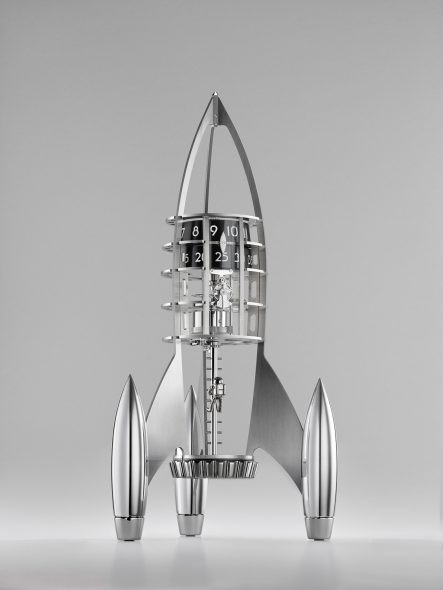
Destination Moon in detail
Inspiration
Destination Moon is a true collaboration between L’Epée 1839 and MB&F; the base concept originated with L’Epée movement designer and sci-fi rocket fan Nicolas Bringuet, who came up with the idea for the movement’s distinctive vertical architecture. Driven by passion, Bringuet designed the movement over one long, largely sleep-free, weekend. L’Epée then contacted MB&F wondering if some type of spacecraft might be designed around the movement and the project blasted off.
MB&F intern-designer Stefano Panterotto came up with the basic shape, however it initially looked too realistically rocket-like and that something magical was missing. Paradoxically, the answer to adding magic was in removing the skin of the rocket so it both looked more technical − helped by the perforated Meccano-like movement plates− and acted as a framework for the viewer’s imagination.
The real magic of Destination Moon is space; not the space of the cosmos above our heads, but the largely empty space that is Destination Moon. If the body of the rocket was completely covered, observers would see the rocket of somebody else’s youth, but because the rocket-themed desktop clock is in reality a largely empty, perforated frame, those viewing Destination Moon are each likely to see a slightly different spacecraft: the rocket of their own childhood rather than somebody else’s… Space isn’t empty; it’s filled by imagination.
Realisation
While designed by MB&F, Destination Moon was constructed by L’Epée 1839, Switzerland’s premier producer of high-end clocks. The concentric vertical construction of the eight-day movement was developed especially for Destination Moon, but it also draws strong parallels with MB&F’s recently launched Horological Machine No.7 Aquapod: while one is a spacecraft-inspired table clock and the other a jellyfish-inspired aquatic wristwatch, both feature movements comprising concentric vertical architecture and both are powered from their base.
Perhaps the crowning jewel of Destination Moon – its apogee if you will – is the small figure on the ladder at its base: Neil. Constructed of solid sterling silver with a stainless steel helmet and wearing a 1960s-style spacesuit, Neil brings a playful human element to the engineering of the Meccano-style openwork of the spaceship and its clockwork. Neil magnetically attaches anywhere along Destination Moon’s boarding ladder. Whether he is embarking to take off for an adventure in space, or disembarking for an adventure on the moon’s surface is up to the individual viewer’s imagination.
Clockwork
Power for Destination Moon comes from the massive crown in its base, which transfers power to the mainspring barrel via the boarding ladder. The eye-catching regulator is vertically positioned to allow for maximum appreciation and protected from curious fingers behind a panel of mineral glass.
Two stainless steel discs with stamped white numerals respectively indicate the hours (top) and minutes as they line up with the streamlined double-ended pointer above the regulator. The time is set by a central knob in at the very top of the movement.
The stability of the clock is ensured by the substantial weight of Destination Moon’s three highly polished landing pods.
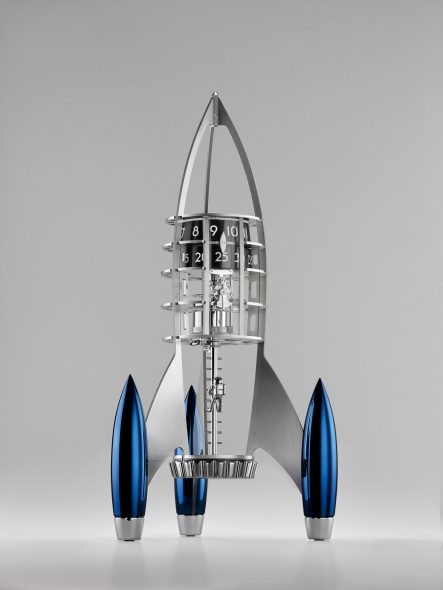
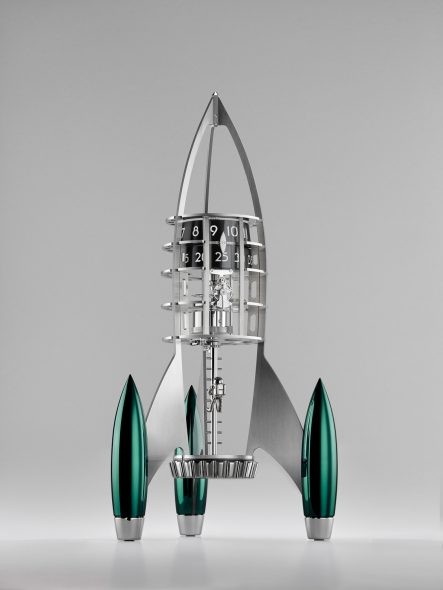

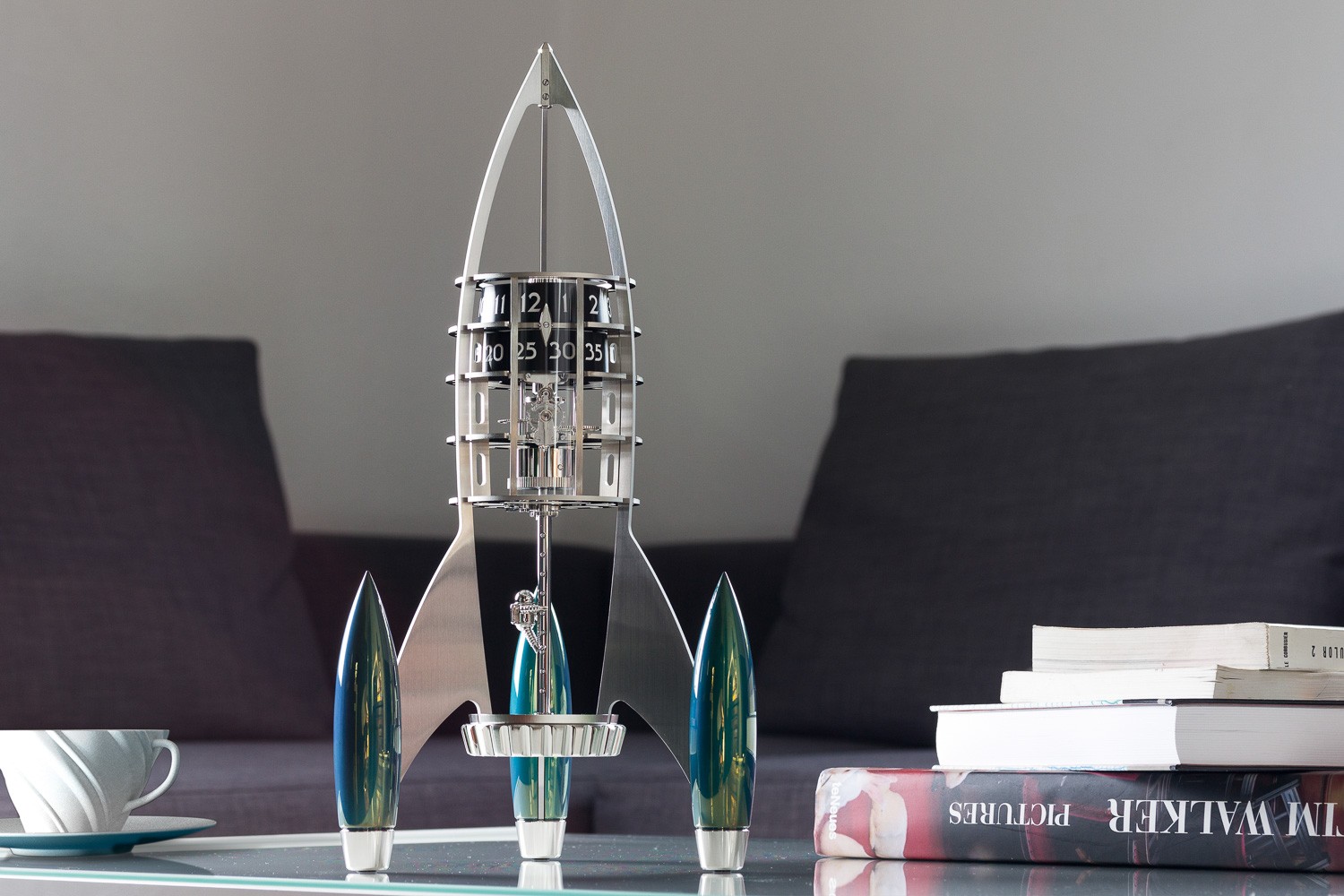
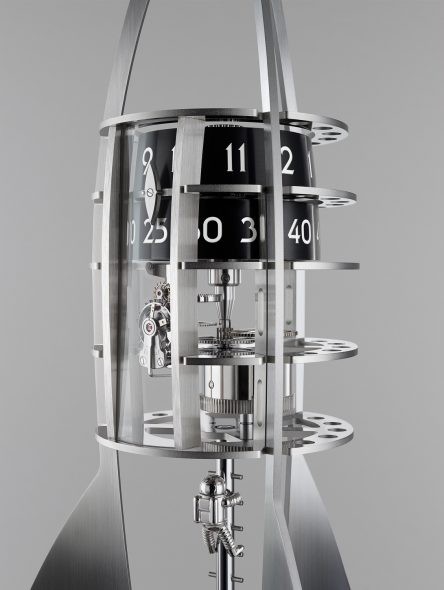
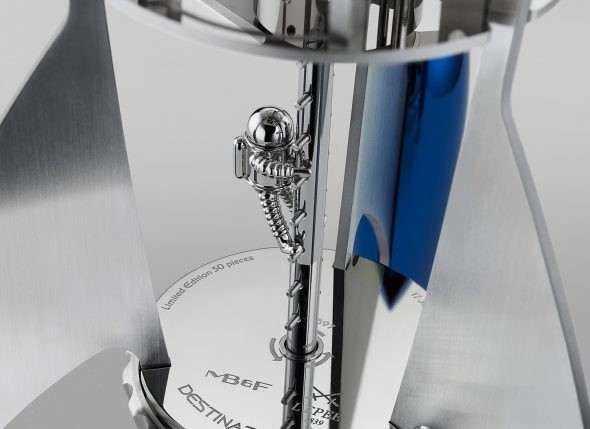
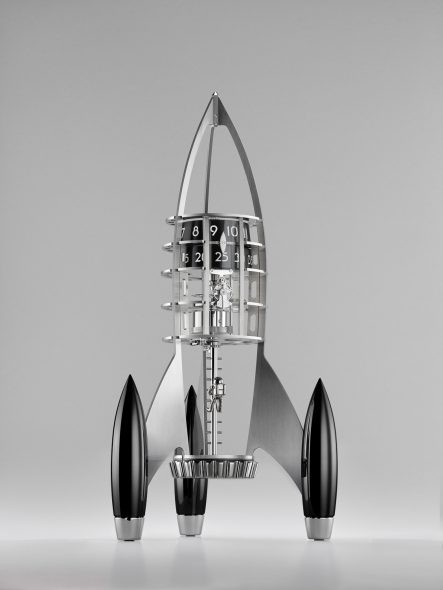
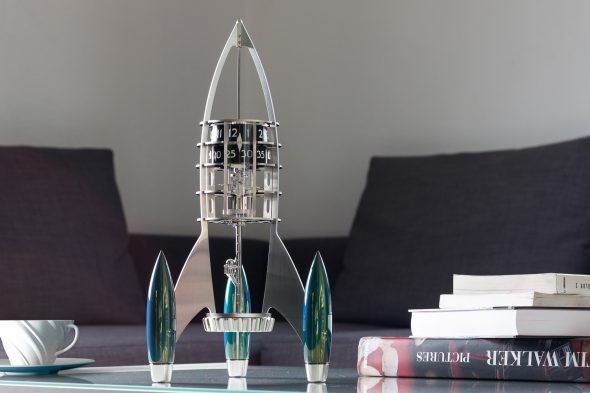
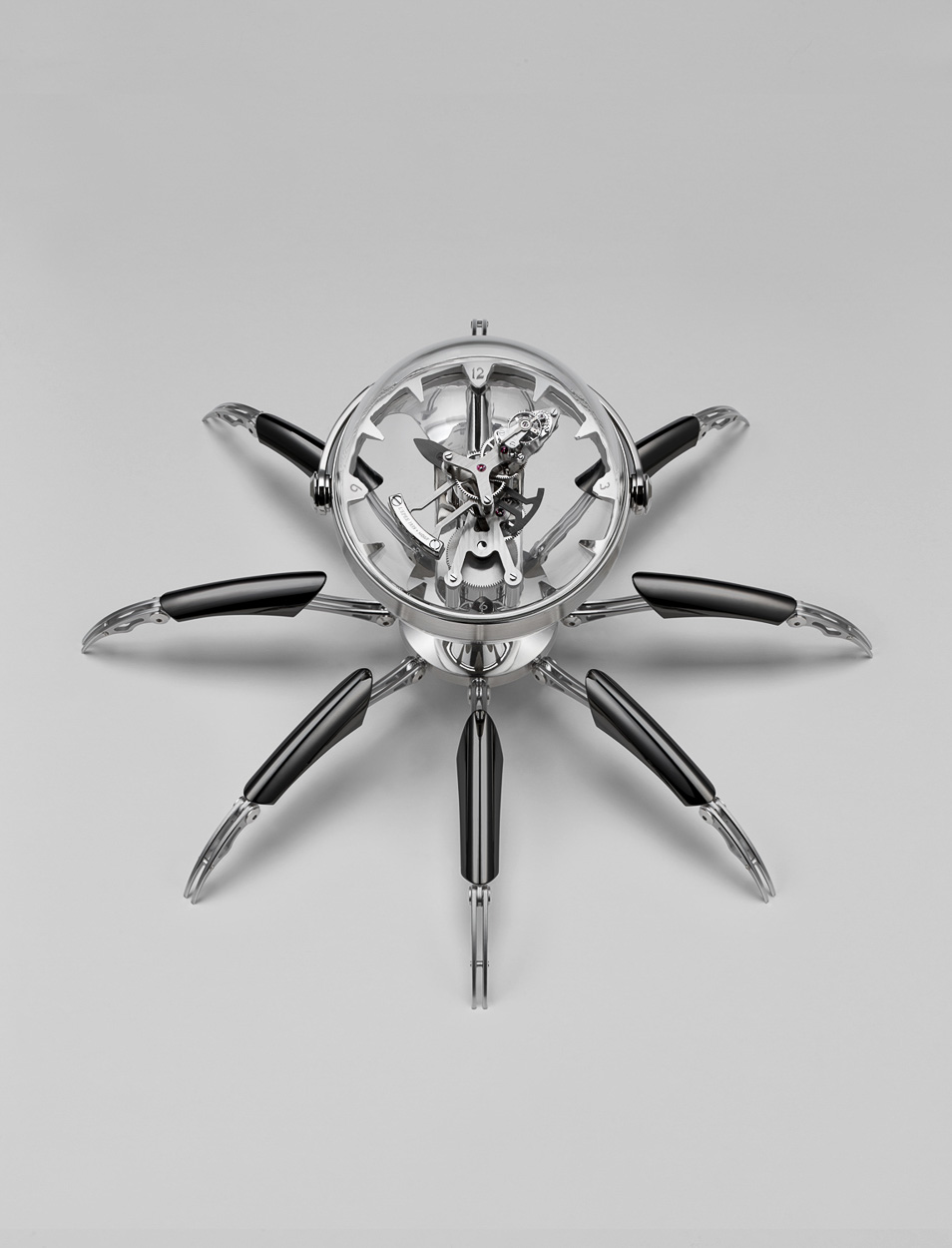
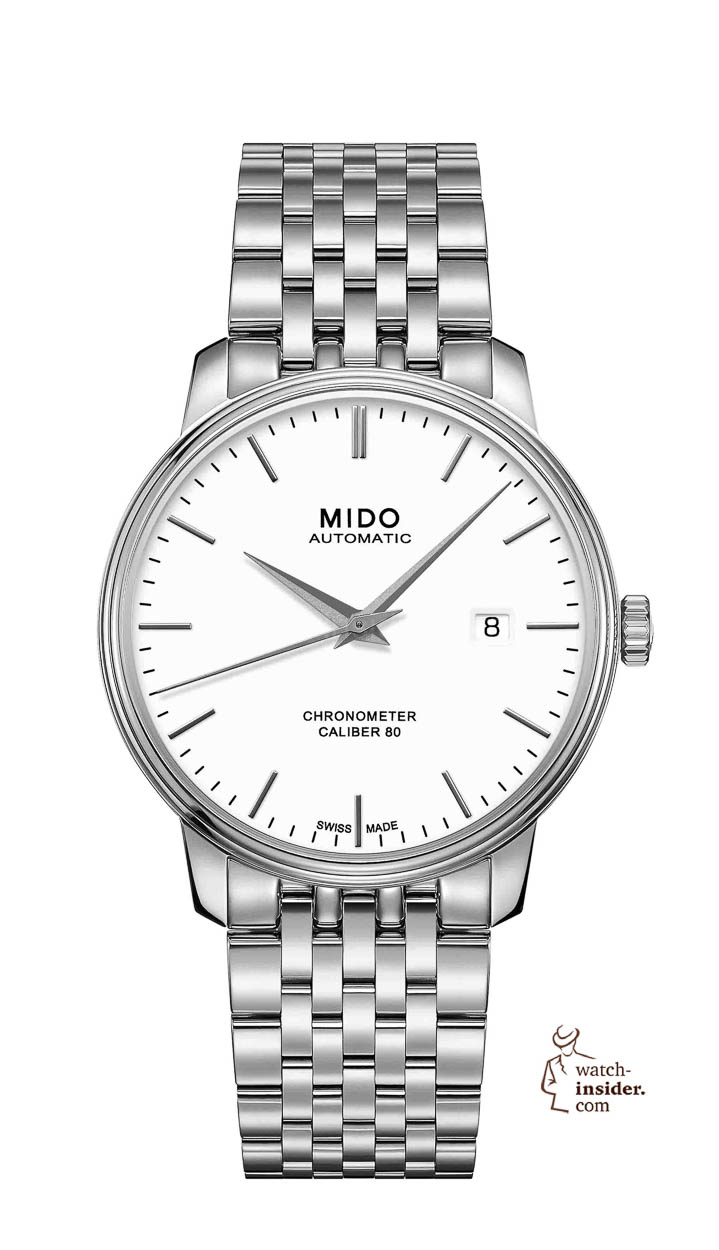
what is the cost in USA dollars?
MB&F got this one right. Mr. Armstrong was the real hero of the Man on the Moon program. His skill and hard work as a pilot and engineer saved the program by not crashing the lunar lander. He risked life and limb practicing in a machine built to simulate the lander. The simulator caught fire, crashed and did its very best to kill him. But he learned to control it and allowed him to make the trip to the alternate landing site on the moon’s surface.
He never exploited his fame. He taught in college after his NASA work.
Good work!